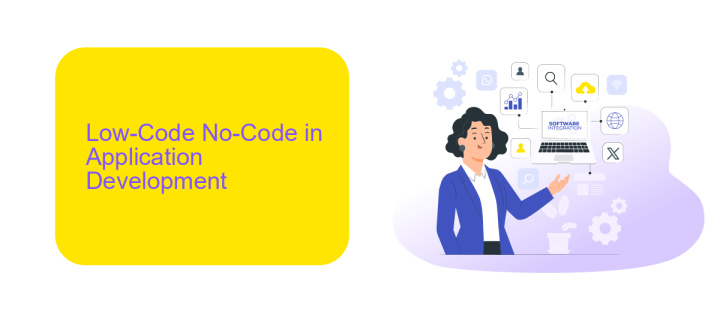Low-Code No-Code Examples
Low-code and no-code platforms are revolutionizing the way businesses develop software, enabling users with little to no programming experience to create applications efficiently. These tools streamline the development process, reduce costs, and accelerate time-to-market. In this article, we will explore various examples of low-code and no-code solutions, showcasing their versatility and impact across different industries.
Low-Code No-Code in Business Processes
Low-code and no-code platforms are revolutionizing business processes by enabling organizations to develop and deploy applications with minimal coding effort. These platforms empower non-technical users to create workflows, automate tasks, and integrate various services, thereby enhancing operational efficiency and reducing the dependency on IT departments.
- Streamlining workflow automation
- Enhancing customer relationship management (CRM) systems
- Facilitating seamless integration between different software tools
- Reducing time-to-market for new applications
- Enabling rapid prototyping and iterative development
One notable example is ApiX-Drive, a service that simplifies the integration of various applications and services without the need for extensive coding. By using ApiX-Drive, businesses can easily connect their CRM, marketing tools, and other software, ensuring a smooth data flow and improving overall productivity. This approach not only saves time but also allows companies to focus on strategic initiatives rather than technical hurdles.
Low-Code No-Code in Application Development

Low-code and no-code platforms have revolutionized application development by enabling users to create complex applications with minimal coding knowledge. These platforms provide drag-and-drop interfaces, pre-built templates, and visual development tools that simplify the development process, allowing businesses to quickly deploy applications. This approach not only accelerates time-to-market but also reduces the dependency on specialized IT skills, making app development accessible to a broader audience.
One crucial aspect of application development is integrating various services and APIs to enhance functionality. Low-code and no-code platforms often come with built-in integration capabilities, streamlining the process of connecting different systems. For instance, services like ApiX-Drive facilitate seamless integration by allowing users to connect multiple applications without writing a single line of code. This enables businesses to automate workflows and improve efficiency, further demonstrating the power and flexibility of low-code and no-code solutions in the modern development landscape.
Low-Code No-Code in Data Management

In the realm of data management, low-code and no-code platforms are transforming how businesses handle their data. These platforms empower users with minimal technical knowledge to create and manage complex data workflows, integrations, and automations. This democratization of technology enables faster decision-making and operational efficiency.
- Data Integration: Tools like ApiX-Drive facilitate seamless integration between various data sources, allowing for real-time data synchronization without the need for extensive coding.
- Data Visualization: Low-code platforms enable the creation of custom dashboards and reports, making data insights accessible to all stakeholders.
- Data Cleaning: Automated workflows can be set up to clean and preprocess data, ensuring high-quality datasets for analysis.
- Data Governance: No-code solutions help in setting up data governance policies, ensuring compliance and data security with minimal manual intervention.
By leveraging low-code and no-code tools, businesses can significantly reduce the time and cost associated with traditional data management processes. These platforms offer scalability and flexibility, making it easier to adapt to changing business needs. As a result, organizations can focus more on strategic initiatives rather than getting bogged down by technical complexities.
Low-Code No-Code in Collaboration and Communication

Low-code and no-code platforms are revolutionizing the way teams collaborate and communicate. By simplifying the development process, these tools enable non-technical users to create and manage applications that streamline workflows and enhance productivity.
One of the key benefits of low-code and no-code platforms is their ability to integrate various communication tools seamlessly. For instance, platforms like ApiX-Drive allow users to connect different services without writing a single line of code, ensuring that data flows smoothly between systems.
- Automated notifications and alerts
- Real-time data synchronization
- Customizable dashboards for team insights
- Integration with popular messaging apps like Slack and Microsoft Teams
These features enable teams to stay connected and informed, reducing the time spent on manual updates and repetitive tasks. As a result, organizations can focus on strategic initiatives and drive innovation, leveraging the power of low-code and no-code solutions to enhance collaboration and communication.
- Automate the work of an online store or landing
- Empower through integration
- Don't spend money on programmers and integrators
- Save time by automating routine tasks
Low-Code No-Code in Cloud Computing
Low-code and no-code platforms have revolutionized cloud computing by enabling users to build and deploy applications with minimal hand-coding. These platforms provide intuitive interfaces and pre-built templates, allowing even non-technical users to create complex workflows and integrations. This democratization of application development accelerates digital transformation and reduces the dependency on specialized IT skills, making it easier for businesses to adapt to changing market demands.
One notable example is ApiX-Drive, a service that simplifies the integration of various cloud applications. With ApiX-Drive, users can automate data transfer between different platforms without writing a single line of code. This not only saves time but also ensures data consistency and accuracy across systems. By leveraging low-code and no-code solutions like ApiX-Drive, organizations can streamline their operations, improve efficiency, and focus on strategic initiatives rather than getting bogged down by technical complexities.
FAQ
What is Low-Code/No-Code development?
Can Low-Code/No-Code platforms handle complex integrations?
Are Low-Code/No-Code platforms suitable for enterprise-level applications?
What are some common use cases for Low-Code/No-Code platforms?
Can non-developers really build applications using Low-Code/No-Code platforms?
Time is the most valuable resource in today's business realities. By eliminating the routine from work processes, you will get more opportunities to implement the most daring plans and ideas. Choose – you can continue to waste time, money and nerves on inefficient solutions, or you can use ApiX-Drive, automating work processes and achieving results with minimal investment of money, effort and human resources.


